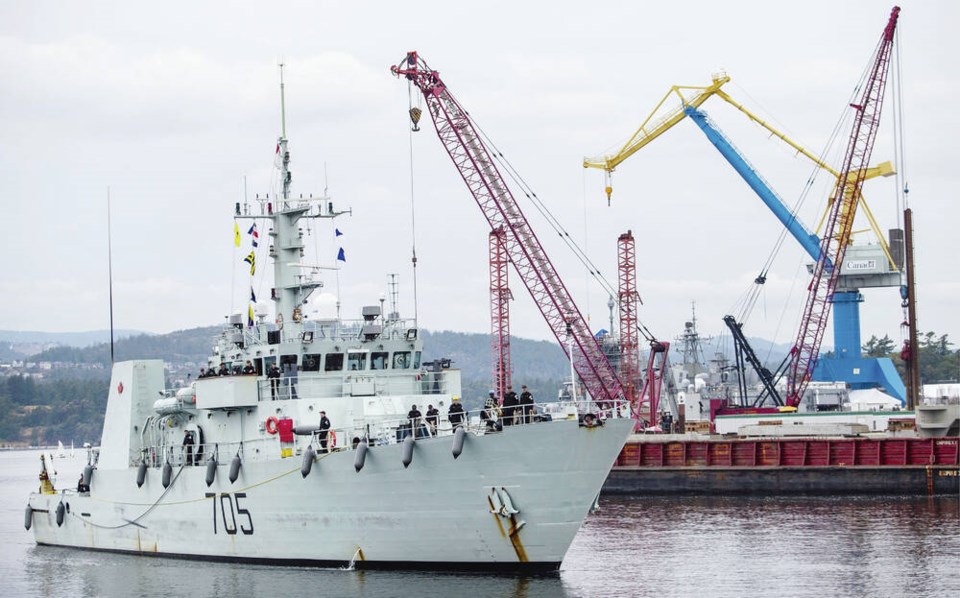Canada is not at war today, but the world is nonetheless in chaos. “We are gridlocked in colossal global dysfunction,” United Nations Secretary-General António Guterres said, adding that “our world is in peril — and paralyzed.”
Canada is a maritime nation bordering on three oceans, and it must have vital maritime forces at its disposal that is ready and able to deliver in the event of hostilities, across a spectrum of naval operations.
The navy’s mission is to generate combat-capable, multi-purpose maritime forces that support Canada’s participation in security operations anywhere in the world. Yet it is doubtful the navy could be capable of conducting its mission today given how it is equipped, and its personnel shortfall.
The navy operates 30 surface ships. There are 12 Halifax-class frigates. There are 12 Maritime Coastal Defence Vessels (MCDV), which are built to commercial standards and not fitted with weapon systems, and hence non-combatants.
There are six Arctic Offshore Patrol Ships (AOPS); three are now built and there are three more to come. They are Arctic capable but not fitted with naval combat systems and also non-combatants.
The navy also operates four used Victoria-class submarines. Yet, it has only two trained crews for four submarines. It will acquire two Joint Support Ships by 2027, and personnel shortages may pose a problem.
So, Canada has 12 combat-capable surface ships to meet its mission requirements. As a comparison, the Chinese navy has about 500 combat-capable warships, and the U.S. Navy assessed the number of combat-capable ships needed to meet its mission requirements to be 373.
What is Canada’s assessment of combat ships needed?
The 12 frigates are not enough to carry out its mission, the navy needs more capable ships, fitted with up-to-date weapon systems. A balanced and cost-effective fleet needs to be created now.
On the horizon there is the replacement of the existing 12 Halifax-class frigates with the construction of 15 91原创 Surface Combatant (CSC), or Type 26 frigates. However, it is behind schedule and its cost keeps growing. The ships were originally expected to cost $14 billion. Currently, the government estimates the cost of the CSC project could be up to $60 billion.
However, the Parliamentary Budget Office now estimates the fleet of new frigates will cost $77.3 billion to build and is estimated to reach $80 billion due to ongoing delays. This works out to more than $5 billion for a single frigate.
The 15 CSC project is ambiguous and expensive, and it is rumoured that given the cost and delays the government will likely settle with a lesser a number of new frigates.
But instead of having a fleet that is composed of some numbers of new frigates, even if it is 15, plus 18 others that are non-combatants, there should be more balanced and affordable units.
For instance, building a reduced number of frigates, and replacing the non-combatant 12 MCDV with smaller and less expensive warships that are fitted with naval weapons systems that can carry out all the naval missions.
A prime candidate should be the European Patrol Corvette (EPC). The EPC is now to be procured by several European nations and it should also be acquired by Canada. The program to build a new corvette includes Italy, France, Greece, Spain, Norway and Denmark.
The requirements are for a smaller and less costly warship, and the first build is scheduled to start in 2025. An industrial source stated that each vessel is expected to cost around €300 million ($400 million Cdn).
The EPC is being touted as a poster child for European defence integration. The produced design is said to constitute a breakthrough from current warships, as it will be modular and flexible, as well as more energy-efficient, greener, safer and more interoperable.
The new CSC frigate will have a displacement of 8,000 tons, a complement of 208 personnel, and an estimated cost of $5 billion each. On the other hand, the EPC corvette will have displacement of 3,300 tons, and a complement of 100 personnel. With design and program costs added, it is expected that 91原创 cost would be $1 billion.
So, six CSC frigates would cost $30 billion, and 10 EPC corvettes would cost $10 billion, which would bring the total for 16 new ships at $40 billion, as compared with the acquisition of 15 CSC frigates at $80 billion.
With the mix of frigates and corvettes, all the missions attributed to the navy would be achievable. Also, the corvettes will require less than half of the personnel needed to sail the frigates, which should ease the navy personnel shortages, and it is estimated that there would be a personnel requirement reduction of about 900.
Given their technologically advanced systems, corvettes would serve to facilitate the integration of reserve sailors to the state-of-the-art systems fitted on the frigates.
There are unstable conditions existing throughout the world; there is unrest and conflict, and Canada’s peace and security certainly cannot be ascertained.
The 91原创 government has promised a robust package of military resource investments to bolster Canada’s defences. As a prominent nation in the world, Canada must be always ready to protect itself, and if necessary to aid its allies should they come under attack. Canada must be strong, secure and engaged.
Hence, the navy must be always ready and able to face any hostilities and must have the resources to carry out all relevant missions.



